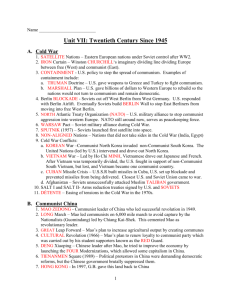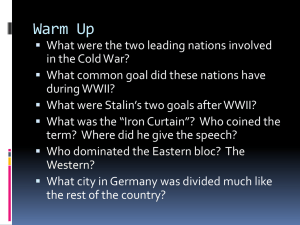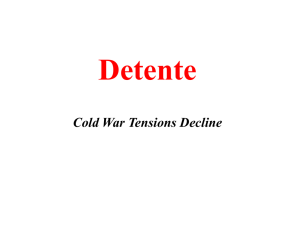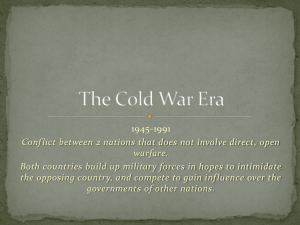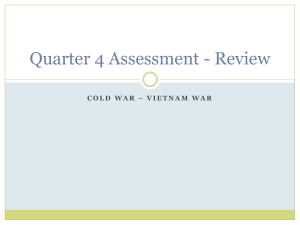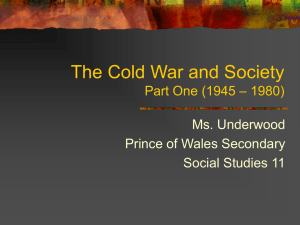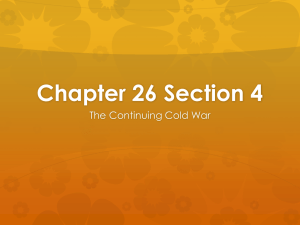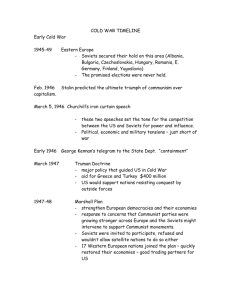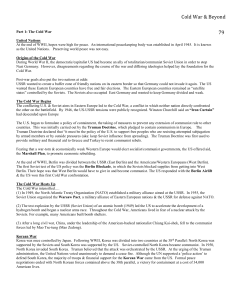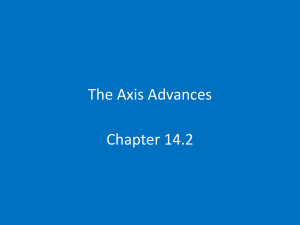Cold War
advertisement
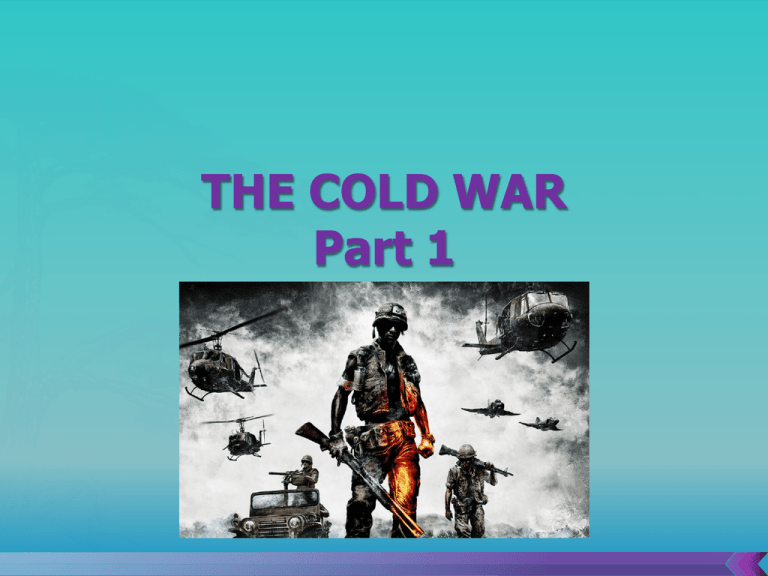
June 1945, 50 nations formed the United Nations—international organization All members represented in General Assembly; 11 on Security Council Five permanent members have Security Council veto power U.S. and Soviets split sharply after WWII ends U.S. was (and still is) world’s richest and most powerful country after WWII Soviets were recovering from high war casualties and many destroyed cities Soviets controlled Eastern European countries after World War II Stalin installed Communist governments in several countries Truman urged free elections but Stalin refuses In 1946, Stalin said capitalism and communism cannot co-exist Germany divided; East Germany - Communist, West Germany Democratic Iron Curtain—Winston Churchill’s name for the division of Europe Containment—U.S. plan to stop the spread of communism Truman Doctrine—U.S. supported countries that rejected communism Congress approved Truman’s request for aid to Greece and Turkey Much of Western Europe was in ruins after World War II Marshall Plan—U.S. program of assisting Western European countries Congress approved plan after Communist takeover of Czechoslovakia In 1948, U.S., Britain, France withdrew forces from West Germany Berlin Blockade - Soviets stopped land and water traffic and trade into West Berlin West Berlin, which was located in Soviet occupation zone, faced starvation U.S. and Britain flew in supplies for 11 months until the blockade ended Cold War—struggle of U.S., Soviet Union using means short of war In 1949, U.S., Canada, West European countries form NATO NATO—North Atlantic Treaty Organization was a defensive military alliance In 1955, Soviets, Eastern European nations signed Warsaw Pact alliance In 1961, Soviets built Berlin Wall to separate East and West Berlin Soviet Union exploded its first atomic bomb in 1949 U.S. and Soviet Union both developed more powerful hydrogen bomb (nuclear proliferation – building more nuclear weapons) Brinkmanship—policy of willingness to go to the edge of war Increasing tensions led to military buildup by U.S. and Soviets In October 1957, Soviets launched Sputnik, first unmanned satellite Launching of Sputnik caused U.S. to spend more money on education and technology and to develop more rigorous science and math programs In 1960, Soviets shot down American spy plane, increasing tensions • ao Zedong—led Chinese Communists against Japanese invaders M Jiang Jieshi (Chiang Kai-shek)—leader of Chinese Nationalists in World War II; lost support because he ignored the needs of the peasants Nationalist and Communist Chinese resume civil war after WWII ends Mao’s troops took control of China’s major cities In 1949, People’s Republic of China created; Nationalists migrated to Taiwan Mao took property from landowners and divided it among peasants Government seized private companies and planned production increase The Great Leap Forward established communes—large collective farms often supporting over 25,000 people Program is ended after inefficiency led to crop failures and famines Red Guards—militia units formed to enforce strict communism in China Cultural Revolution—movement to build society of peasants and workers Red Guards closed schools and executed or imprisoned many intellectuals In 1968, Chinese army imprisoned, executed, or exiled most of the Red Guards 38th parallel—line dividing Korea into North Korea and South Korea In 1950, North Koreans invaded South Korea with Soviet support South Korea requested UN assistance; 15 nations send troops Douglas MacArthur—led UN forces against North Koreans North Koreans controlled most of peninsula when MacArthur attacks Half of the North’s army surrendered, the rest retreated UN troops pushed North Koreans almost to Chinese border Chinese sent 300,000 troops against UN forces and captured Seoul MacArthur called for nuclear attack and is removed from command In 1953, cease fire signed and border established at 38th parallel Ho Chi Minh—Vietnamese Communist leader In 1954, French surrendered to Vietnamese after major defeat Domino theory—U.S. theory of Communist expansion in Southeast Asia; one nation falls, the rest will follow International peace conference agreed on a divided Vietnam Ngo Dinh Diem—led anti-Communist government in South Vietnam Vietcong—South Vietnamese Communist guerillas who fought against Diem In 1964, U.S. sent troops to fight Vietcong and North Vietnamese U.S. fought guerilla war Vietcong gained support from Ho Chi Minh, China, Soviet Union War grew unpopular in U.S.; in 1969, Nixon starts withdrawing troops Vietnamization—Nixon’s plan to withdraw U.S. from war gradually Last U.S. troops left in 1973; South Vietnam was overrun in 1975 Saigon renamed Ho Chi Minh City; Vietnam united as Communist nation About 1.5 million people fled Vietnam; some settled in U.S., Canada In 1995, United States normalized relations with Vietnam Khmer Rouge—Communist rebels who took control of Cambodia in 1975; led by Pol Pot Attempts at agricultural reform led to widespread famine Arbitrary executions and torture carried out by its cadres against perceived subversive elements Purged their own ranks They slaughtered 2 million people; Khmer Rouge is overthrown by proCommunist, but moderate Vietnamese invaders In 1993, Cambodia adopted democracy, held elections with UN help U.S., Soviet Union, China competed for influence over Third World by backing revolutions and giving economic, military, technical aid Third World—developing nations; often newly independent, nonaligned Nonaligned nations (nonalignment)—independent countries not involved in Cold War Many countries, like India, wanted to avoid involvement in Cold War Fidel Castro—led a revolt in Cuba against dictator (Batista) who was supported by U.S. In 1959, Castro gained power, nationalized economy, and seized U.S. property Bay of Pigs Invasion - In 1961, Castro’s forces defeated U.S.-trained Cuban exiles at Bay of Pigs; CIA trained these Cubans but they failed to assassinate Castro Cuban Missile Crisis - In 1962, U.S. demanded the removal of Soviet missiles in Cuba; Soviets withdrew missiles and U.S. promised not to invade Cuba; nuclear war was averted

